Asus P4T-E
|
Installation Like the MSI board I had a little while back, this board makes full use of the extra width that a 9-hole ATX mount gives you. Almost all AMD boards I've had the pleasure to have used the 6-hole mount and have been thinner, both the i850's I've seen have used all the available ATX width. This doesn't hinder the installation of the board in any way however. It may be a tight squeeze in some smaller cases but given a decent sized case it should be fine. The extra width is accounted for mostly by the RIMM layout. The P4T-E also requires the use of the extra power connectors that Intel's P4 solutions require to provide the extra voltage that the CPU needs and also an auxiliary power connector not disimilar to one half of the old split AT power connector. Apart from the need to drag those wires across the board, everything is fine. Installation of the GlacialTech Igloo 4300 heatsink was simple. I had the choice of GlacialTech or the stock Intel cooler and both are simple to install. I prefer the clip on the Igloo to the Intel one so the GlacialTech was used. Board Layout 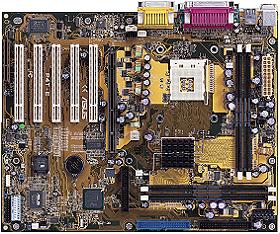 Board layout is fairly standard with nothing out of place. Starting at the top we've got the ATX connector flush along the top left edge and the auxiliary ATX connector at right angles to that in the top right. Moving down we hit the first bank of RIMM slots parallel to the top edge with the CPU socket area directly underneath. Following the Intel socket design to the letter means that any standard P4 sink fits with no problem at all. Moving right we hit the i850 MCH covered by a black heatsink. This is clipped to the board using a Z/S shaped clip. It's removable allowing for installation of a replacement sink that uses the same clip design. Then we hit RIMM bank 2 which or orientated with the vertical right hand edge of the PCB. The two IDE ports are vertical and flush with the far right edge in the top half of the board. The floppy connector is at right angles underneath the second bank of RIMMs. I would have prefered it flush with the right edge in a vertical orientation since the extra cable twist is an annoyance. Underneat the MCH is the 12V supply connector for the CPU. From there on down we have a standard layout of 5 PCI slots, the CNR slot and the case headers. Near the case headers we have the USB header for extra ports (supplied on a backplane) and the DIP switch block for manual adjust of FSB and CPU multiplier. The CPU multi and FSB controls are also available in the BIOS if needed. The P4T-E is a completely jumper free motherboard if you choose. Now that I've seen the layout of the MSI and the Asus, I understand the reasoning behind the awkward RIMM placement. Again, the only things that bother me on the i850 layouts I've seen are the RIMM placement and the extra, but currently necessary, extra power connectors. Performance So now that we've looked at the spec, installation and layout, what's performance like? We'll use the same benchmarks we used in the MSI review with a few crucial changes. For starters, we've moved to WindowsXP as the test operating system and we've also switched to the new version of SiSoft Sandra. If you want to take a look at what makes up the P4 and it's Netburst architecture, take a look here. Before we get started, lets take a look at the test rig:
Despite using a 2Ghz Pentium 4 ES processor, for parity with the MSI review and easy comparison I've run at the same speeds as I did in the MSI review and also at 133Mhz FSB which I was unable to do in the MSI review. Having an engineering sample CPU lets you pick your multiplier with the CPU being unlocked. So speeds used were 18 x 100 (1.8), 18 x 111 (2Ghz) and 15 x 133 (2Ghz). The Asus proclaims support for the upcoming Northwood CPU's at 133Mhz FSB so I decided to prove that claim. Standard Performance (18 x 100, 1.8Ghz) Lets start with Sandra numbers and move on to Povray and some 3DMark. 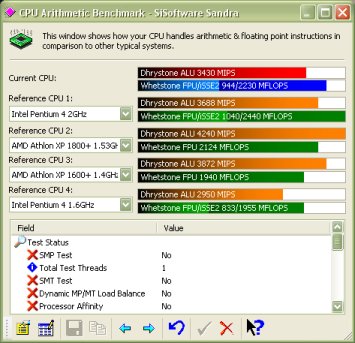 Here we see the stock arithmetic bench falling into line with what Sandra expect from a 1.8Ghz P4. Nothing amazing except it's maybe slighty higher than normal. More on that later. 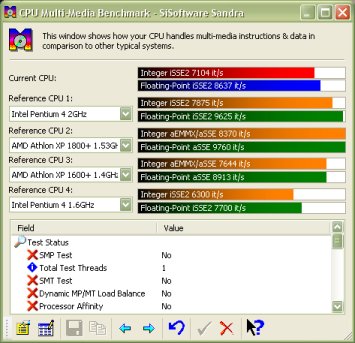 Again, nothing special but possibly slightly higher than a 1.8 bench on another board.  These numbers are higher than what we'd expect from Sandra but this is the latest version of Sandra where the memory benchmark code has changed a fair bit and the benchmarks give new scales of results. The new version does prefetching and buffering on the data used to get the resulting benchmark numbers hence the new, higher scale. For the next round of tests, we have Povray v3.1g with recompiled unofficial binaries for the P3/Athlon and the P4. The P3 binary runs on all current CPU's without any problems and the P4 binary will only run on the P4 since it uses specific P4 instructions. It shows us the effect that software recompiled and optimised for the Pentium 4 can have on their execution speed. First up the P3 binary. Again we used the following command line for all tests and the pawns.pov scenesobjects directory: -i +v1 +ft -x +mb25 +a0.300 +j1.000 +r3 -q9 -w640 -H480 -S1 -E480 -k0.000 -mv2.0 +b1000  The same benchmark on the MSI i850 running at the same speed took 62 seconds. This follows on from what we saw during the Sandra testing that might not be apparent at first from glancing at the Sandra graphs. The Asus is ever so slightly faster than the MSI in all tests so far. Next, the P4 binary run.  Here we see an oddity. This run on the MSI took 45 seconds as opposed to 47 seconds here. I ran the benchmark a total of 10 times to see if the slightly high time was an anomaly, but 46 seconds was the quickest it managed the render. 47 cropped up 9/10 times. Therefore in this benchmark, the Asus takes a slight back seat. The result is too close to really call given testing anomalies including a change of operating system, but it still stands. It goes to show what an optimised piece of software can do when running on the Pentium 4 processor. It's a shame that software needs to be specifically optimised for the platform but that's necessary in this case. Finally, we have 3DMark 2001 Pro from the guys at MadOnion.com.  On the MSI using the 21.85 drivers the 1.8GHz P4 scored 6231 3DMarks. Bearing in mind the MSI was running Windows 2000 Professional SP2, the Asus running newer drivers and Windows XP Professional has gained approximately 720 points. We can attribute the bulk of this to the new drivers. NVIDIA have done a sterling job with the 22.xx Detonators and they have new found performance. Overall, good stock performance where we expected it. The 1.8GHz P4 processor is a good performer on the i850 platform. One thing we did notice however on the Asus at 100Mhz FSB was a slight overclock of the FSB by the board itself. WCPUID confirms this by showing the FSB to be hovering around the 101Mhz FSB mark when set to 100 in the BIOS. While not a staggering amount, it is deliberate. We can attribute the increases we saw in the Sandra marks to that slight increase in FSB by the board. Overclocked performance (18 x 111, 2GHz) Lets see how a small bus overclock on the i850 helps things out. Multiplier is constant at 18x and we've simply overclocked the FSB. Again, we'll take a look at the Sandra results first. 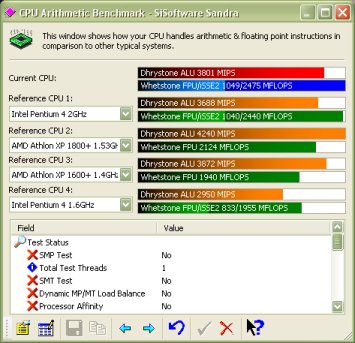 We are nearly exactly consistent with the results provided by Sandra itself for the 2Ghz Pentium 4 processor. 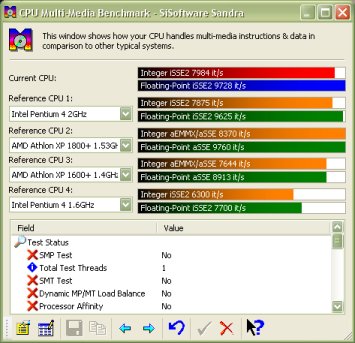 Again, nearly exactly where we should be given Sandra's reference results showing that nothing untoward is happening with the i850 on the Asus. 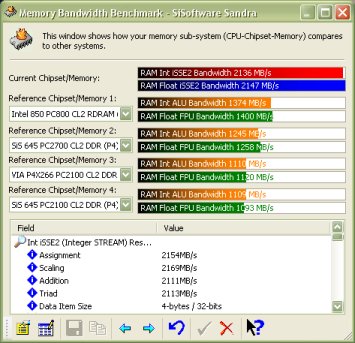 Here we see the result for 20 x 100 being basically the same as 18 x 100. As expected due to the same FSB. Excellent scores too from the new version of Sandra. Next up, we have Povray. It's worth nothing that like the synthetic CPU benchmarks we use in Sandra, Povray is almost entirely CPU bound. An increase in CPU speed corresponds to a quicker render time for a given scene in Povray. First, the P3 binary result.  This is identical to the score we saw on the MSI board at 55 seconds. Performance of the 2 boards is identical at 18 x 111 showing that the i850 is doing it's stuff properly on each board. Next, the P4 result.  Again, this is the avarage result of 10 runs, all of them consistent and again it falls slightly behind the MSI when running the P4 binary. The time difference is only 1 second but it mirrors what we saw at 1.8Ghz. Here we can see the increase that running an increased FSB on the P4 gives us. Finally, the 3DMark score.  This is the first default bench over 7000 we've had in a review system at Hexus and 7165 out of the box with no tweaks on a GeForce3 is impressive, especially on Windows XP. The new drivers help a lot in this case. For most 1.8Ghz chips, 2Ghz shouldn't be a problem and with the system only running at a mild 111Mhz FSB, everything should be safe. The free performance to be gained is excellent. Overclocked Performance (133 x 15, 2GHz) Asus make a big deal of the fact the P4T-E will be able to run the upcoming Northwood P4's, the next evolution of the P4 design. Some of those new processors will run on a 133/533MHz FSB so we thought, given that the unlocked ES processor was being used and available, we should knock down the multiplier and try 133 to see if everything was good. 15 x 133 gives 2000Mhz spot on, the rated speed for the processor so I had no need to increase CPU Vcore. Done entirely through the BIOS it was a 10 second task. All that was needed was to decrease the RAMBUS multiplier to 3x from 4x to keep the stick in spec at 400Mhz. 533Mhz was no go for the pair of modules used. Apart from that, actually setting for 133Mhz was easy. However there were 2 side effects to doing so. USB stopped working and the onboard AC'97 audio was disabled so I lost mouse control and sound. Maybe a BIOS update can solve those problems or maybe it's an issue with running the ICH2 at that speed since it handles both functions. Either way, they need to be solved before we can consider recommending the board for 133Mhz operation. However, just out of curiosity, we ran the numbers to see if 133Mhz was a win for the P4. Bear in mind the throttled RAMBUS at a stock 400Mhz and expect another increase from being able to run it at 533Mhz and you are there. First up, as always, Sandra. 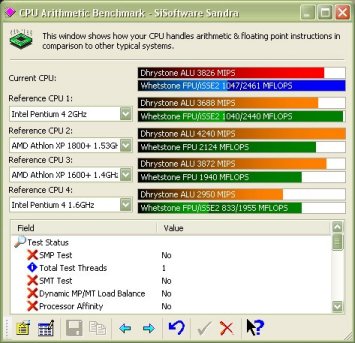 You can't really see the effect of the increased FSB using Sandra's synthetic, all CPU speed benchmarks. Onto the multimedia bench. 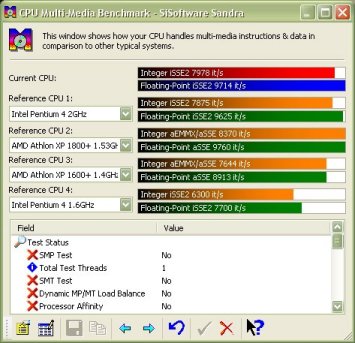 Again, this benchmark is a test of raw CPU MHz and not a test of the increased bandwith available at the higher FSB speed. Onto the memory bench. 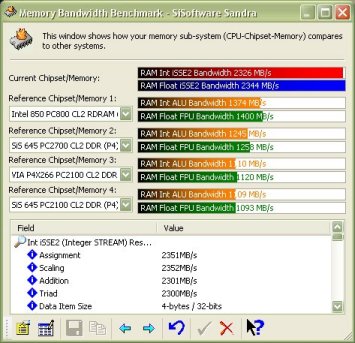 Here we see the 133Mhz FSB having a proper effect on the scores. We get an approximate 10% increase in the resulting score for 33% increase in the FSB. While not everyone has the luxury of an ES processor for running at 133Mhz and keeping the resulting clock speed reasonable, it does highlight what you should see in the future with the upcoming processors. Next up, our Povray benches at 133Mhz FSB. We shouldn't see much of an increase, if any since the CPU speed is the same. The P3 binary result is first, followed by the P4 binary result.   As we see, being a CPU test, the Povray results at 15 x 133 are the same as for 20 x 100. Finally 3DMark 2001 Professional.  130 points isn't earth shattering but considering 3DMark 2001 results are heavily dependant on card performance we can be happy with the increase given. It's not as large as I had hoped since increasing FSB on an AMD DDR system gives heavy increases in 3DMark points. Performance Conclusion The Asus holds its own very well against the MSI we tested not long ago, equalling performance in all areas. Stock 3DMark performance is the fastest we've yet seen, however this is due to NVIDIA's good work on the drivers in the most part. It's very similar speed wise to the MSI and it helped along very slightly by the slightly overclocked FSB at 100Mhz. Overall, it's a high performance solution given a fast Pentium 4 processor. RAMBUS, while not on many peoples shortlist for cool company of the year do have a high performance memory solution for Intel to pair with the i850. One thing I did notice during testing was the sharp decrease in audio playback performance during moments of high CPU load. During a copy of around 20Gb of data from one of my disks to another, audio playback from Winamp was poor. Since the onboard sound is AC'97 and so uses the CPU for it's processing, rather than dedicated hardware, this is to be expected. However it was extremely annoying and a dedicated hardware solution should be sought and used on the Asus if audio playback is a priority. Maybe a new driver can help things along in that department and we'll report back on this if we hear anything. To conclude, performance is high and the system was very stable throughtout all the testing. Overall conclusion I give the Asus points for 5 PCI and support for Northwood processors are support for 133Mhz FSB chips. While running at 133Mhz FSB wasn't perfect due to USB and AC'97 audio going walkabout, I'm hopeful a new BIOS will cure those ailments. Layout is good and as usual from Asus the board was incredibly stable throughout. Komplett.co.uk have them in stock as I type this for just under UK£163 which is the same price as the Abit TH7-II i850 motherboard, also from Komplett. There are a few niggles on the board like the AC'97 audio stuttering and the 133Mhz issues, but overall I'm very impressed with my 2nd look at an i850 solution. Very good indeed. |













